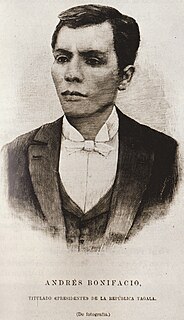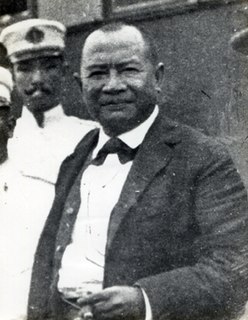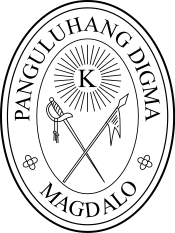
Emilio Aguinaldo y Famy was a Filipino revolutionary, politician and military leader who is officially recognized as the first and the youngest President of the Philippines (1899–1901) and first president of a constitutional republic in Asia. He led Philippine forces first against Spain in the latter part of the Philippine Revolution (1896–1898), and then in the Spanish–American War (1898), and finally against the United States during the Philippine–American War (1899–1901).

The Kataas-taasang, Kagalang-galangang Katipunan ng mga Anak ng Bayan, also known as Katipunan or KKK, was a Philippine revolutionary society founded by anti-Spanish colonialism Filipinos in Manila in 1892; its primary goal was to gain independence from Spain through a revolution.

Andrés Bonifacio y de Castro was a Filipino revolutionary leader and the president of the Tagalog Republic. He is often called "The Father of the Philippine Revolution". He was one of the founders and later Supremo of the Kataas-taasang, Kagalang-galangang Katipunan ng mga Anak ng Bayan or more commonly known as the "Katipunan", a movement which sought the independence of the Philippines from Spanish colonial rule and started the Philippine Revolution. He was also one of the Filipino historical figures to be recommended as a national hero of the Philippines.

The Philippine Revolution, called the Tagalog War by the Spanish, was a revolution and subsequent conflict fought between the people and insurgents of the Philippines and the Spanish colonial authorities of the Spanish East Indies, under the Spanish Empire.

Maragondon, officially the Municipality of Maragondon,, is a heritage town and a 3rd class municipality in the province of Cavite, Philippines. According to the 2015 census, it has a population of 37,720 people. The town is famous for its bamboo crafts, Mounts Palay-Palay–Mataas-na-Gulod Protected Landscape which includes Mount Pico de Loro, and various ancestral houses and structures important to Philippine history and culture such as Maragondon Church and the execution site and trial house of national hero Andres Bonifacio.

Baldomero Aguinaldo y Baloy was a leader of the Philippine Revolution. He was the first cousin of Emilio Aguinaldo, the first president of the Philippines, as well as the grandfather of Cesar Virata, a former prime minister in the 1980s.

Mariano Álvarez was a Filipino revolutionary and statesman.

Mariano Trías y Closas is considered to be the first de facto Philippine Vice President of that revolutionary government established at the Tejeros Convention - an assembly of Philippine revolutionary leaders that elected officials of the revolutionary movement against the colonial government of Spain. When that assembly broke into factions, a truce known as the Pact of Biak-na-Bato was signed by the group and also recognized the elected officials and Trias as the vice president of Emilio Aguinaldo, who is also considered to be the first President of the Philippines. With the promulgation of the Malolos Constitution by the Malolos Convention, the First Philippine Republic was born. Under this Aguinaldo administration, Trias served in the cabinet initially as Secretary of Finance and, later, as Secretary of War.

The Tejeros Convention was the meeting held on March 22, 1897 between the Magdiwang and Magdalo factions of the Katipunan at San Francisco de Malabon, Cavite. These are the first presidential and vice presidential elections in Philippine history, although only the Katipuneros were able to take part, and not the general populace.

The Magdiwang was a chapter of the Katipunan, a Philippine revolutionary organization founded by Filipino rebels in Manila in 1892, with the aim to gain independence from Spain. The Magdiwang Council was acknowledged "as the supreme organ responsible for the successful campaigns against the enemy."

General Licerio Topacio (1839–1925) was a leader in the Philippine Independence movement.
Daniel Tria Tirona was a Filipino revolutionary leader. He participated in the Philippine Revolution against Spanish colonial rule and in the Philippine–American War.Attacked Bonifacio for not being a lawyer and being the Director of Interior in the Convention of Tejeros.
Procopio Bonifacio y de Castro was a Filipino independence activist and revolutionary during the Philippine Revolution of 1896 against Spain. He was a member of the secret revolutionary society turned revolutionary government Katipunan with his other siblings Ciriaco and Espiridiona. His eldest brother Andrés Bonifacio was one of the founders and, eventually, president of the Katipunan.
The Imus Assembly was the meeting held between the Magdalo and Magdiwang factions of the Katipunan at Imus, Cavite, Philippines, on December 31, 1896, the day following the execution of José Rizal. This was convened in order to settle the leadership dispute between the two factions.

The Battle of Binakayan-Dalahican was a simultaneous battle during the Philippine Revolution that was fought from November 9–11, 1896 that led to a decisive Filipino victory. The twin battle took place at the shores of Binakayan, in the town of Cavite Viejo ; Dalahican and Dagatan in Noveleta; and, to minimal extent, in Imus and Bacoor towns in Cavite province, Philippines that lasted for two days before the Spanish army retreated demoralized and in disarray. The result of the battle was the first significant Filipino victory in the country's history.

The Battle of Noveleta was a major battle during the Philippine revolution and was one of the very first engagements of the revolution in Cavite. In the latter part of the revolution, Noveleta played a key role for the Magdalo and Magdiwang factions. From its capture by the Magdiwang at the start of the revolution, various battles were fought and won by Filipino rebels in Cavite. Noveleta became the seat of the Magdiwang faction of the Katipunan.

The Roderico Reyes Ancestral House, more commonly known as the Bonifacio Trial House, is a historic house and museum in Maragondon, Cavite, Philippines. It was built in 1889 and served as a military court, wherein it has been a witness to the trial of Andres Bonifacio in 1897.

Bonifacio: Ang Unang Pangulo is a 2014 Philippine historical action drama film centering on the life of Katipunan revolutionary Andres Bonifacio. It is an official entry to the 40th Metro Manila Film Festival.

The Baldomero Aguinaldo Shrine is a single-detached house built by Gen. Baldomero Aguinaldo, cousin of Gen. Emilio Aguinaldo during the American Colonial Period in 1906 at Binakayan, Kawit, Cavite. Baldomero held several positions at the revolutionary government during the early 1900s. He became the head of the Kawit Chapter of the Katipunan, President of the KKK Magdalo Council, and Secretary of the Treasury in the 1897 Biak-na-Bato Republic. Also, he became the Secretary of War and Public Works after the establishment of the First Philippine Republic by Emilio Aguinaldo.
This is the timeline of the Philippine Revolution. It contains the events before and during the revolution.
















